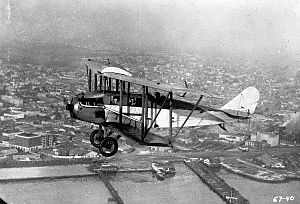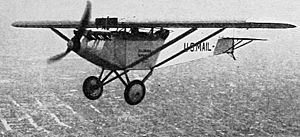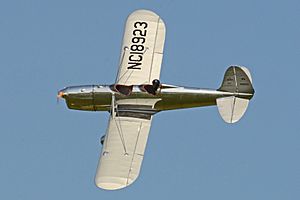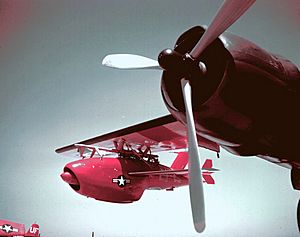T. Claude Ryan facts for kids
Quick facts for kids
T. Claude Ryan
|
|
|---|---|
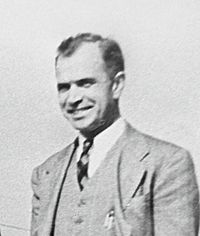 |
|
| Born | January 3, 1898 |
| Died | September 11, 1982 (aged 84) |
| Occupation | Aviator, aerospace engineer |
Tubal Claude Ryan (born January 3, 1898 – died September 11, 1982) was an American aviator and engineer. He was born in Parsons, Kansas. Ryan became famous for starting several airlines and airplane factories. He played a big part in the early days of flying.
Contents
Early Flying Adventures
Ryan started his flying journey in 1917. He joined the American School of Aviation in Venice, California. After his first solo flight, he wanted to join the Army Air Service. But World War I ended just as he was about to report.
Instead, Ryan studied engineering at Oregon State College. He then joined the U.S. Army's Aeronautical Division. He learned to fly at March Field, California, and finished his training in 1921. Ryan flew patrols for forests until 1922. After leaving the Army, he moved to San Diego. He gave "barnstorming" rides to people. These were exciting, short flights to show off flying skills. He used the money to buy a military Curtiss JN-4 Jenny plane.
Starting Aviation Businesses
First Steps in Business
Claude Ryan hired Hawley Bowlus as his first employee. Bowlus had been his mechanic at his first flying school. Ryan later sold half of his company, the Ryan Flying Company, to Benjamin Franklin Mahoney in 1925. With Mahoney's money, they bought a Douglas Cloudster plane. This plane was meant for the first non-stop flight across the United States. However, another team completed this flight first.
Bowlus changed the Cloudster to carry 10 passengers. They also had three "Ryan-Standards" that could carry four passengers each. With these planes, they started The San Diego - Los Angeles Airlines. This airline began flying passengers regularly between San Diego, California and Los Angeles, California on March 1, 1925.
Building Ryan Airplanes
The company's first plane they built was the Ryan M-1 monoplane. A monoplane is a plane with only one set of wings. This plane was designed to carry mail and first flew in 1926. The M-1 was first started by William J. Waterhouse. Ryan bought the project and Hawley Bowlus finished building it. Ryan proudly showed it off in San Diego. An improved version, the M-2, was also made. It had a stronger wing.
On November 23, 1926, Ryan sold his share in all three companies to Benjamin Franklin Mahoney. He was still working for the company at the end of that year. After this, Ryan was not involved in building Charles Lindbergh's famous plane, the Spirit of St. Louis. However, the Spirit of St. Louis was based on the design of Ryan's M-1 plane.
The "New" Ryan Aeronautical Corporation
After selling his first companies, Ryan bought the rights to sell a German engine called the Siemens-Halske Sh 12. He put one of these engines on a Ryan M-2 plane. In early 1927, he traveled around the country to sell these engines. He called them the Ryan-Siemens 9.
Later that year, he started the T. C. Ryan Flying School in San Diego. In October, he formed the first Ryan Aeronautical Corporation to sell the engines. He was later sued for using the "Ryan" name without "T. C." to show it was different from his old company. The German company also bought him out. Ryan then took a break from business.
In 1931, Ryan opened a new flying school called the 'Ryan School of Aeronautics'. This school helped train many pilots for the government before World War II. Ryan decided to build his own training planes. In 1932, he started the "new" Ryan Aeronautical Corporation. This was his fourth and last company.
His first plane from this new company was the S-T Sports Trainer, which flew in 1934. The ST was a very successful design. It was used by many civilian and military groups around the world. Over 1,500 were built.
During World War II, Ryan's company built the FR-1 Fireball fighter plane. This plane used both a jet engine and a piston engine. They also built a prototype for an improved version called the XF2R-1 Dark Shark.
After the war, Ryan's company bought the design for the North American Navion plane and built it as the Ryan Navion. They also created and produced the Firebee and similar drones. Drones are unpiloted aircraft. These drones were used a lot during the Vietnam War.
Ryan's company also worked on experimental vertical take-off and landing (VTOL) aircraft. These planes could take off and land straight up and down, like a helicopter. Examples include the X-13 Vertijet and the XV-5 Vertifan. However, none of these experimental planes went into full production.
In 1969, Ryan sold Ryan Aeronautical to the Teledyne Corporation. The company was renamed Teledyne-Ryan. It continued to make drones and parts for helicopters like the AH-64 Apache. Later, Teledyne sold the drone part of the business to Northrop Grumman.
Later Life and Legacy
After retiring, Ryan started another company with his son, Jerome. They wanted to build and sell the Ryan ST-100 Cloudster. This was a motor glider, a type of plane that can fly like a glider but also has an engine. Ryan designed it himself. He passed away before the plane went into production, and only one was ever completed.
T. Claude Ryan died on September 11, 1982, in San Diego, California. His wife, Zeta Gladys Bowen Ryan, passed away in 1997.
Honors and Awards
- 1948 - Presidential Certificate of Merit: Given by President Harry S. Truman for Ryan Aeronautical's help in the Allied war effort.
- 1958 - Horatio Alger Award
- 1965 - Inducted into the International Aerospace Hall of Fame.
- 1966 - Mr. San Diego: An award given by San Diego's civic leaders.
- 1970 - Fellow of the American Institute of Aeronautics and Astronautics.
- 1971 - Service to Aviation Award: From the National Business Aircraft Show.
- 1974 - Inducted into the National Aviation Hall of Fame.
- 1975 - Honorary Fellow of the Society of Experimental Test Pilots.
- 1981 - Aerospace Life Achievement Award: Given by AIAA San Diego to a pioneer in aerospace.
- 1982 - Honorary Fellow of the American Institute of Aeronautics and Astronautics.


